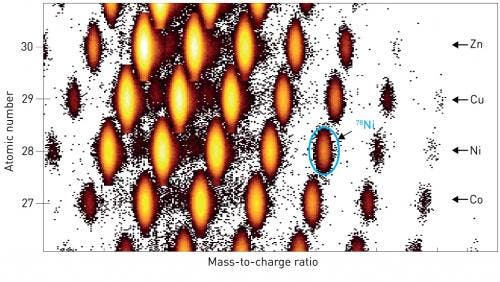Some atoms are more stable than others, and the same goes for their isotopes – elements that have the same number of protons in the nucleus, but different number of neutrons. For instance, some decay in a trillionth of a second, while others can live on for billions of years. Actually, using isotopes (thorium and uranium decay) scientists were able to refine the dating for our planet’s age. The Earth is 4.54 billion years old.
The most exceptional isotopes are those that contain a ‘magic number’, as defined by scientists.The seven most widely recognized magic numbers are 2, 8, 20, 28, 50, 82 and 126, corresponding to the total number of protons and neutrons needed to completely fill the nuclear shells. Nickel-78 is perhaps the oddest of isotopes, and has been giving physicists headaches for ages because it is a ‘doubly magic’ isotope.
The nickel-78 (78-Ni) isotope contains 28 protons and 50 neutrons, making it doubly magic according to this series, but isotopes that exhibit such an excess of neutrons over protons are predicted to have a different magic number, according to models. This has prompted some scientists to say Nickel-78 isn’t magic at all.

: Heat map showing the production of exotic isotopes at the RIKEN Radioactive Isotope Beam Factory (RIBF). This facility can produce nickel-78 (78Ni) in yields sufficient for highly precise decay measurements. Credit: The American Physical Society
Helping put an end to the debate are Shunji Nishimura and colleagues from the RIKEN Nishina Center for Accelerator-Based Science who have performed extensive experiments on Nickel-78.
“Many experiments have been carried out to identify systematic trends in nuclear properties near 78Ni,” says Nishimura. “Yet there has been no clear evidence on whether 78Ni is a double-magic nuclei due to the extremely low production yield of this isotope.”
The team used RIKEN’s Radioactive Isotope Beam Factory, which is capable of generating high yields of exotic and rare isotopes like 78Ni, as show in the figure above. Using this facility, in combination with the newly developed WAS3ABi detector, the research team was able to perform measurements of 78Ni decay with unprecedented precision. The experiments confirmed the doubly magic status of 78Ni, providing valuable insights into the behavior of exotic nuclei with large neutron excess. Such neutron-rich nuclei play an important role in the production of elements heavier than the most stable element iron, such as gold and uranium.
“We hope to solve one of the biggest mysteries of this century—where and how were the heavy elements created in the Universe?” explains Nishimura.
Findings were detailed in a paper published in the journal Physical Review Letters.









